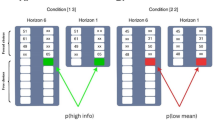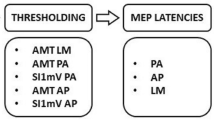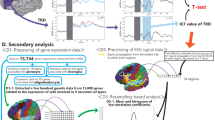Abstract
Short-interval intracortical inhibition (SICI) and intracortical facilitation (ICF) are noninvasive transcranial magnetic stimulation (TMS) measures of GABAA receptor-mediated inhibition and glutamatergic excitatory transmission, respectively. Conventionally these measures have been restricted to the motor cortex. We investigated whether SICI and ICF could be recorded from the dorsolateral prefrontal cortex (DLPFC) using combined TMS and electroencephalography (TMS–EEG). We first characterized the neural signature of SICI and ICF in M1 in terms of TMS-evoked potentials (TEPs) and spectral power modulation. Subsequently, these paradigms were applied in the DLPFC to determine whether similar neural signatures were evident. With TMS at M1, SICI and ICF led to bidirectional modulation (inhibition and facilitation, respectively) of P30 and P60 TEP amplitude, which correlated with MEP amplitude changes. With DLPFC stimulation, P60 was bidirectionally modulated by SICI and ICF in the same manner as for M1 stimulation, whereas P30 was absent. The sole modulation of early TEP components is in contradistinction to other measures such as long-interval intracortical inhibition and may reflect modulation of short latency excitatory and inhibitory postsynaptic potentials (EPSPs and IPSPs). Overall, the data suggest that SICI and ICF can be recorded using TMS–EEG in DLPFC providing noninvasive measures of glutamatergic and GABAA receptor-mediated neurotransmission. This may facilitate future research attempting to ascertain the role of these neurotransmitters in the pathophysiology and treatment of neurological and psychiatric disorders.
Similar content being viewed by others
Log in or create a free account to read this content
Gain free access to this article, as well as selected content from this journal and more on nature.com
or
References
Bartos M, Vida I, Jonas P (2007). Synaptic mechanisms of synchronized gamma oscillations in inhibitory interneuron networks. Nat Rev Neurosci 8: 45–56.
Berchou R, Chayasirisobhon S, Green V, Mason K (1986). The pharmacodynamic properties of lorazepam and methylphenidate drugs on event-related potentials and power spectral analysis in normal subjects. Clin Electroencephalogr 17: 176–180.
Chen R, Curra A (2004). Measures of cortical inhibition in health and disease. Suppl Clin Neurophysiol 57: 691–701.
Claus D, Weis M, Jahnke U, Plewe A, Brunholzl C (1992). Corticospinal conduction studied with magnetic double stimulation in the intact human. J Neurol Sci 111: 180–188.
Coxon JP, Stinear CM, Byblow WD (2006). Intracortical inhibition during volitional inhibition of prepared action. J Neurophysiol 95: 3371–3383.
Daskalakis ZJ, Christensen BK, Fitzgerald PB, Roshan L, Chen R (2002). The mechanisms of interhemispheric inhibition in the human motor cortex. J Physiol 543 (Pt 1): 317–326.
Daskalakis ZJ, Farzan F, Barr MS, Maller JJ, Chen R, Fitzgerald PB (2008). Long-interval cortical inhibition from the dorsolateral prefrontal cortex: a TMS-EEG study. Neuropsychopharmacology 33: 2860–2869.
Deng C, Huang XF (2006). Increased density of GABAA receptors in the superior temporal gyrus in schizophrenia. Exp Brain Res 168: 587–590.
Di Lazzaro V, Pilato F, Dileone M, Ranieri F, Ricci V, Profice P et al (2006a). GABAA receptor subtype specific enhancement of inhibition in human motor cortex. J Physiol 575 (Pt 3): 721–726.
Di Lazzaro V, Pilato F, Oliviero A, Dileone M, Saturno E, Mazzone P et al (2006b). Origin of facilitation of motor-evoked potentials after paired magnetic stimulation: direct recording of epidural activity in conscious humans. J Neurophysiol 96: 1765–1771.
Di Lazzaro V, Restuccia D, Oliviero A, Profice P, Ferrara L, Insola A et al (1998). Magnetic transcranial stimulation at intensities below active motor threshold activates intracortical inhibitory circuits. Exp Brain Res 119: 265–268.
Farzan F, Barr MS, Hoppenbrouwers SS, Fitzgerald PB, Chen R, Pascual-Leone A et al (2013). The EEG correlates of the TMS-induced EMG silent period in humans. Neuroimage 83: 120–134.
Farzan F, Barr MS, Levinson AJ, Chen R, Wong W, Fitzgerald PB et al (2010). Evidence for gamma inhibition deficits in the dorsolateral prefrontal cortex of patients with schizophrenia. Brain 133 (Pt 5): 1505–1514.
Farzan F, Barr MS, Wong W, Chen R, Fitzgerald PB, Daskalakis ZJ (2009). Suppression of gamma-oscillations in the dorsolateral prefrontal cortex following long interval cortical inhibition: a TMS-EEG study. Neuropsychopharmacology 34: 1543–1551.
Ferreri F, Pasqualetti P, Maatta S, Ponzo D, Ferrarelli F, Tononi G et al (2011). Human brain connectivity during single and paired pulse transcranial magnetic stimulation. Neuroimage 54: 90–102.
Ferreri F, Ponzo D, Hukkanen T, Mervaala E, Kononen M, Pasqualetti P et al (2012). Human brain cortical correlates of short-latency afferent inhibition: a combined EEG-TMS study. J Neurophysiol 108: 314–323.
Fingelkurts AA, Kivisaari R, Pekkonen E, Ilmoniemi RJ, Kahkonen S (2004). The interplay of lorazepam-induced brain oscillations: microstructural electromagnetic study. Clin Neurophysiol 115: 674–690.
Fitzgerald PB, Daskalakis ZJ, Hoy K, Farzan F, Upton DJ, Cooper NR et al (2008). Cortical inhibition in motor and non-motor regions: a combined TMS-EEG study. Clin EEG Neurosci 39: 112–117.
Fitzgerald PB, Maller JJ, Hoy KE, Thomson R, Daskalakis ZJ (2009). Exploring the optimal site for the localization of dorsolateral prefrontal cortex in brain stimulation experiments. Brain Stimul 2: 234–237.
Fuggetta G, Fiaschi A, Manganotti P (2005). Modulation of cortical oscillatory activities induced by varying single-pulse transcranial magnetic stimulation intensity over the left primary motor area: a combined EEG and TMS study. Neuroimage 27: 896–908.
Hone-Blanchet A, Ciraulo DA, Pascual-Leone A, Fecteau S (2015). Noninvasive brain stimulation to suppress craving in substance use disorders: Review of human evidence and methodological considerations for future work. Neurosci Biobehav Rev 59: 184–200.
Ilic TV, Meintzschel F, Cleff U, Ruge D, Kessler KR, Ziemann U (2002). Short-interval paired-pulse inhibition and facilitation of human motor cortex: the dimension of stimulus intensity. J Physiol 545 (Pt 1): 153–167.
Ilmoniemi RJ, Kicic D (2010). Methodology for combined TMS and EEG. Brain Topogr 22: 233–248.
Jensen O, Mazaheri A (2010). Shaping functional architecture by oscillatory alpha activity: gating by inhibition. Front Hum Neurosci 4: 186.
Julkunen P, Jauhiainen AM, Kononen M, Paakkonen A, Karhu J, Soininen H (2011). Combining transcranial magnetic stimulation and electroencephalography may contribute to assess the severity of Alzheimer's disease. Int J Alzheimers Dis 2011: 654794.
Kahkonen S, Komssi S, Wilenius J, Ilmoniemi RJ (2005a). Prefrontal TMS produces smaller EEG responses than motor-cortex TMS: implications for rTMS treatment in depression. Psychopharmacology (Berl) 181: 16–20.
Kahkonen S, Komssi S, Wilenius J, Ilmoniemi RJ (2005b). Prefrontal transcranial magnetic stimulation produces intensity-dependent EEG responses in humans. Neuroimage 24: 955–960.
Kimiskidis V, Papagiannopoulos S, Kazis D, Vasiliadis G, Oikonomidi A, Sotirakoglou K et al (2008). Silent period (SP) to transcranial magnetic stimulation: the EEG substrate. Brain Stimul 1: 315–316.
Komssi S, Kahkonen S, Ilmoniemi RJ (2004). The effect of stimulus intensity on brain responses evoked by transcranial magnetic stimulation. Hum Brain Mapp 21: 154–164.
Kujirai T, Caramia MD, Rothwell JC, Day BL, Thompson PD, Ferbert A et al (1993). Corticocortical inhibition in human motor cortex. J Physiol 471: 501–519.
Liepert J, Schwenkreis P, Tegenthoff M, Malin JP (1997). The glutamate antagonist riluzole suppresses intracortical facilitation. J Neural Transm 104: 1207–1214.
Link CG, Leigh TJ, Fell GL (1991). Effects of granisetron and lorazepam, alone and in combination, on the EEG of human volunteers. Br J Clin Pharmacol 31: 93–97.
Lioumis P, Kicic D, Savolainen P, Makela JP, Kahkonen S (2009). Reproducibility of TMS-Evoked EEG responses. Hum Brain Mapp 30: 1387–1396.
Manganotti P, Formaggio E, Storti SF, De Massari D, Zamboni A, Bertoldo A et al (2012). Time-frequency analysis of short-lasting modulation of EEG induced by intracortical and transcallosal paired TMS over motor areas. J Neurophysiol 107: 2475–2484.
Mazaheri A, Jensen O (2010). Rhythmic pulsing: linking ongoing brain activity with evoked responses. Front Hum Neurosci 4: 177.
Mori F, Ribolsi M, Kusayanagi H, Siracusano A, Mantovani V, Marasco E et al (2011). Genetic variants of the NMDA receptor influence cortical excitability and plasticity in humans. J Neurophysiol 106: 1637–1643.
Noda Y, Cash RF, Zomorrodi R, Garcia Dominguez L, Farzan F, Rajji TK et al (2016). A combined TMS-EEG study of short-latency afferent inhibition in the motor and dorsolateral prefrontal cortex. J Neurophysiol (e-pub ahead of print).
Orth M, Amann B, Ratnaraj N, Patsalos PN, Rothwell JC (2005). Caffeine has no effect on measures of cortical excitability. Clin Neurophysiol 116: 308–314.
Paulus W, Classen J, Cohen LG, Large CH, Di Lazarro V, Nitsche M et al (2008). State of the art: Pharmacologic effects on cortical excitability measures tested by transcranial magnetic stimulation. Brain Stimulation 1: 151–163.
Paus T, Sipila PK, Strafella AP (2001). Synchronization of neuronal activity in the human primary motor cortex by transcranial magnetic stimulation: an EEG study. J Neurophysiol 86: 1983–1990.
Pehrson AL, Sanchez C (2015). Altered gamma-aminobutyric acid neurotransmission in major depressive disorder: a critical review of the supporting evidence and the influence of serotonergic antidepressants. Drug Design Dev Ther 9: 603–624.
Peurala SH, Muller-Dahlhaus JF, Arai N, Ziemann U (2008). Interference of short-interval intracortical inhibition (SICI) and short-interval intracortical facilitation (SICF). Clin Neurophysiol 119: 2291–2297.
Premoli I, Castellanos N, Rivolta D, Belardinelli P, Bajo R, Zipser C et al (2014a). TMS-EEG signatures of GABAergic neurotransmission in the human cortex. J Neurosci 34: 5603–5612.
Premoli I, Rivolta D, Espenhahn S, Castellanos N, Belardinelli P, Ziemann U et al (2014b). Characterization of GABAB-receptor mediated neurotransmission in the human cortex by paired-pulse TMS-EEG. Neuroimage 103: 152–162.
Radhu N, Garcia Dominguez L, Farzan F, Richter MA, Semeralul MO, Chen R et al (2015). Evidence for inhibitory deficits in the prefrontal cortex in schizophrenia. Brain 138 (Pt 2): 483–497.
Rogasch NC, Daskalakis ZJ, Fitzgerald PB (2013). Mechanisms underlying long-interval cortical inhibition in the human motor cortex: a TMS-EEG study. J Neurophysiol 109: 89–98.
Rogasch NC, Thomson RH, Farzan F, Fitzgibbon BM, Bailey NW, Hernandez-Pavon JC et al (2014). Removing artefacts from TMS-EEG recordings using independent component analysis: importance for assessing prefrontal and motor cortex network properties. Neuroimage 101: 425–439.
Rusjan PM, Barr MS, Farzan F, Arenovich T, Maller JJ, Fitzgerald PB et al (2010). Optimal transcranial magnetic stimulation coil placement for targeting the dorsolateral prefrontal cortex using novel magnetic resonance image-guided neuronavigation. Hum Brain Mapp 31: 1643–1652.
Sanger TD, Garg RR, Chen R (2001). Interactions between two different inhibitory systems in the human motor cortex. J Physiol 530 (Pt 2): 307–317.
Schall JD, Godlove DC (2012). Current advances and pressing problems in studies of stopping. Curr Opin Neurobiol 22: 1012–1021.
Schreckenberger M, Lange-Asschenfeldt C, Lochmann M, Mann K, Siessmeier T, Buchholz HG et al (2004). The thalamus as the generator and modulator of EEG alpha rhythm: a combined PET/EEG study with lorazepam challenge in humans. Neuroimage 22: 637–644.
Schwenkreis P, Liepert J, Witscher K, Fischer W, Weiller C, Malin JP et al (2000). Riluzole suppresses motor cortex facilitation in correlation to its plasma level. A study using transcranial magnetic stimulation. Exp Brain Res 135: 293–299.
Schwenkreis P, Witscher K, Janssen F, Addo A, Dertwinkel R, Zenz M et al (1999). Influence of the N-methyl-D-aspartate antagonist memantine on human motor cortex excitability. Neurosci Lett 270: 137–140.
Smith MJ, Adams LF, Schmidt PJ, Rubinow DR, Wassermann EM (2002). Effects of ovarian hormones on human cortical excitability. Ann Neurol 51: 599–603.
Sun Y, Farzan F, Mulsant BH, Rajji TK, Fitzgerald PB, Barr MS et al (2016). Indicators for remission of suicidal ideation following magnetic seizure therapy in patients with treatment-resistant depression. JAMA Psychiatry 73: 337–345.
Van Der Werf YD, Paus T (2006). The neural response to transcranial magnetic stimulation of the human motor cortex. I. Intracortical and cortico-cortical contributions. Exp Brain Res 175: 231–245.
Wagle-Shukla A, Ni Z, Gunraj CA, Bahl N, Chen R (2009). Effects of short interval intracortical inhibition and intracortical facilitation on short interval intracortical facilitation in human primary motor cortex. J Physiol 587 (Pt 23): 5665–5678.
Ziemann U, Chen R, Cohen LG, Hallett M (1998). Dextromethorphan decreases the excitability of the human motor cortex. Neurology 51: 1320–1324.
Ziemann U, Lonnecker S, Steinhoff BJ, Paulus W (1996). The effect of lorazepam on the motor cortical excitability in man. Exp Brain Res 109: 127–135.
Acknowledgements
The authors gratefully acknowledge the assistance of all study volunteers and thank Ms Stacey Shim and Ms Felicity Backhouse for the recruitment of participants.
Author information
Authors and Affiliations
Corresponding author
Additional information
Supplementary Information accompanies the paper on the Neuropsychopharmacology website
Rights and permissions
About this article
Cite this article
Cash, R., Noda, Y., Zomorrodi, R. et al. Characterization of Glutamatergic and GABAA-Mediated Neurotransmission in Motor and Dorsolateral Prefrontal Cortex Using Paired-Pulse TMS–EEG. Neuropsychopharmacol 42, 502–511 (2017). https://doi.org/10.1038/npp.2016.133
Received:
Revised:
Accepted:
Published:
Issue date:
DOI: https://doi.org/10.1038/npp.2016.133
This article is cited by
-
TMS-EEG Shows Mindfulness Meditation Is Associated With a Different Excitation/Inhibition Balance in the Dorsolateral Prefrontal Cortex
Mindfulness (2025)
-
The Supplementary Motor Area as a Flexible Hub Mediating Behavioral and Neuroplastic Changes in Motor Sequence Learning: A TMS and TMS-EEG Study
Neuroscience Bulletin (2025)
-
Stimulation Parameters Recruit Distinct Cortico-Cortical Pathways: Insights from Microstate Analysis on TMS-Evoked Potentials
Brain Topography (2025)
-
Decreased prefrontal glutamatergic function is associated with a reduced astrocyte-related gene expression in treatment-resistant depression
Translational Psychiatry (2024)
-
Investigating the Effects of Repetitive Paired-Pulse Transcranial Magnetic Stimulation on Visuomotor Training Using TMS-EEG
Brain Topography (2024)



